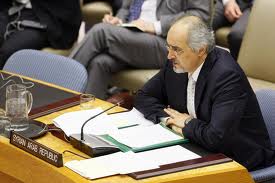As of 11:20 AM EDT on April 14th, 2012, the first resolution on Syria, Resolution 2042, was adopted by the United Nations Security Council, after a year of protests and conflict in the Syrian Arab Republic. The rare weekend meeting of the Council, chaired by Ambassador Susan Rice of the United States of America, comes as tensions in Syria continue to strain the brief cessation of violence. After numerous warnings from Joint Special Envoy of the UN and League of Arab States Kofi Annan, the Syrian government in a surprise turn of events agreed earlier this week to implement a cease-fire and the former Secretary-General’s proposed Six Point plan.
While the Syrian government missed the original Tuesday deadline, in a report to the Security Council on Thursday, Annan indicated that President Bashar al-Assad’s government was at least partly complying with the terms of the peace plan. This was more than enough of an opening for Russia and China to begin to take credit for Annan’s successful efforts, and call for swift approval of a UN monitoring mission to verify the cease-fire.
The United States gladly went to work, and circulated a draft resolution that, in no uncertain terms, demanded that the Syrian government comply with the peace plan, and granted broad powers of investigation to the observer mission. Vitaly Churkin, the Russian Ambassador, balked at this sweeping authority and the political implications of the text, leading to the Russian Mission circulating its own stripped down version of the resolution. In the Russian draft, Western “demands” that Syria provide freedom of access to the monitors were replaced with language “calling upon” the Syrian government to do the same.
Both drafts called for an advance mission of thirty observers to be deployed immediately. According to the Department of Peacekeeping operations, these advance observers would be pulled from other UN missions in the region, with logistics provided from a base in Italy. These blue berets can be deployed into Syria in as little as twenty-four hours from now.
After much negotiation, a new draft was put into blue text, the version that immediately proceeds voting. After a few technical changes by the Russian Mission, the draft taken up by the Council for a vote this morning has been approved by Ambassador Churkin, giving it the green light for adoption. The new version drops the “demands” language, and only “expresses its intention” to deploy a full observer mission, putting off its development for a later resolution, depending on how the cease-fire holds and a report from the Secretary-General on the 19th of April. The Secretary-General is also to report immediately to the Council on any violation by either side in the conflict.
With the passage of a resolution, a small sigh of relief is emanating from the Council chambers. But the battle over Syria is in no way over. The fight among the Security Council members is likely to continue anew once the Secretary-General gives his report in five days. Likewise, the ceasefire itself is tenuous at best; reports are still coming in of Syrian government attacks on protesters, and heavy weapons still remain within cities across the state. It is certain too that the Russian Mission will jump at the chance to lay blame at the feet of the Free Syrian Army should they launch an attack on the Syrian government. All told, the fire may not be blazing anymore, but a spark could easily turn the embers into an inferno once again.
